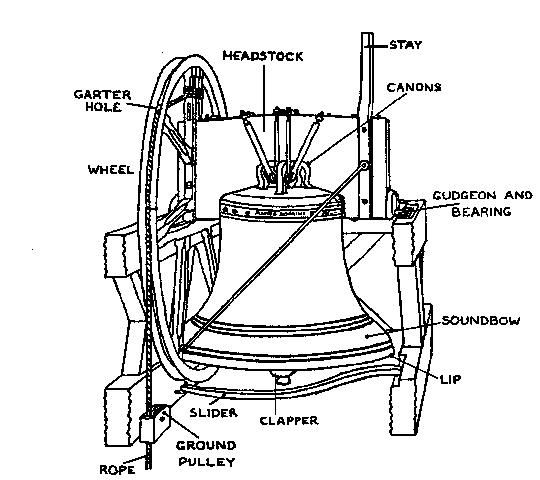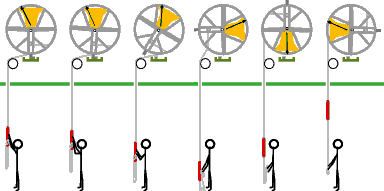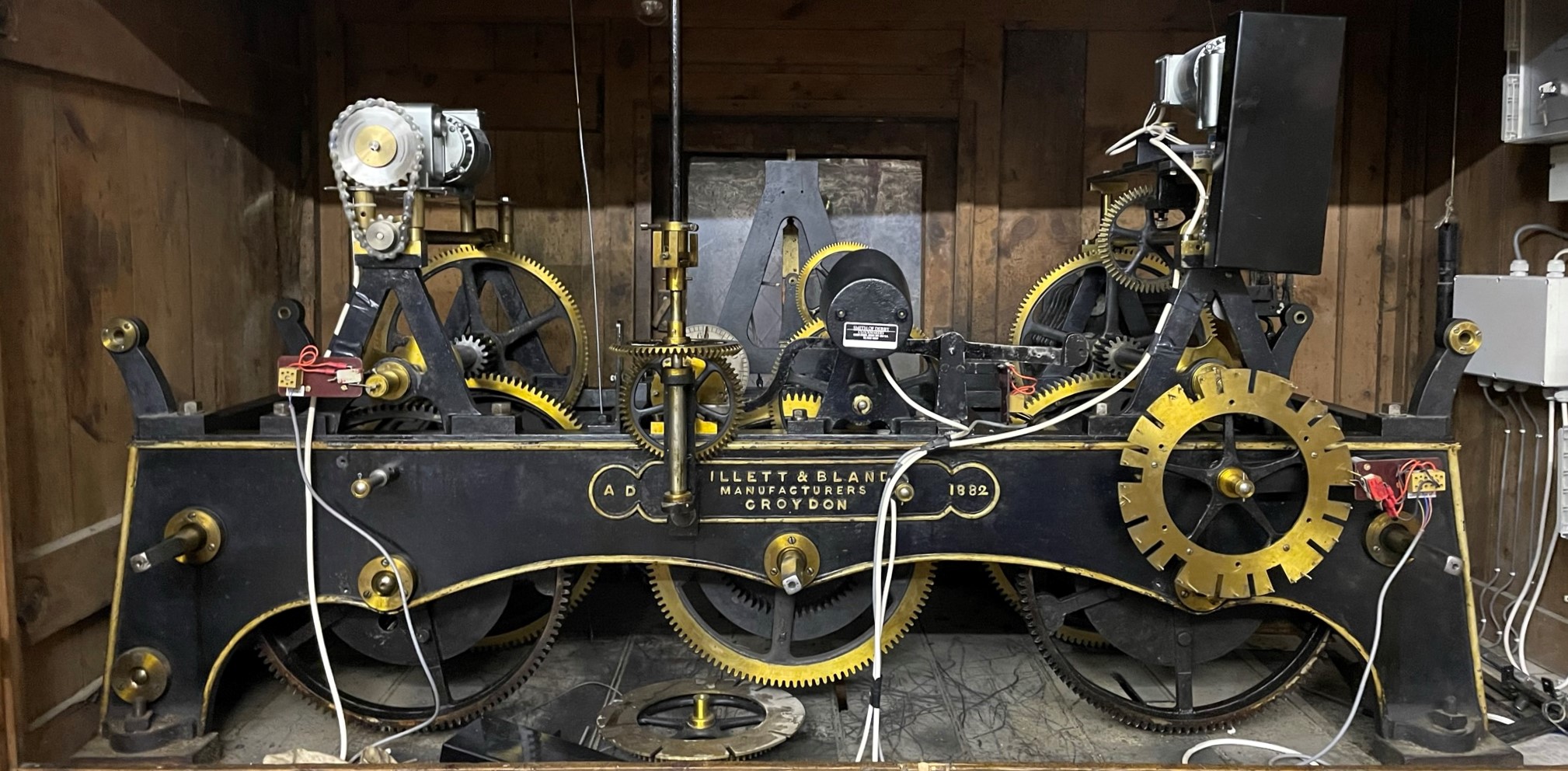What is ringing?
Each bell is attached to its headstock which is supported on bearings on a frame so that the bell swings easily. The earliest bells simply had an arm on the headstock to give leverage. By pulling a rope attached to this arm, the ringer made a bell swing and the bell chimed each time its clapper hit one side or the other. In continental Europe the use of bells swinging and chiming randomly is very prevalent. It is only in England that the art of swinging the bell full circle has been developed fully.

Early in the 17th century, wheels replaced arms in some belfries. By attaching the rope to the wheel and with a groove in the rim of the wheel to retain the rope, the ringer could make a bell swing higher and higher until it could be balanced upside down with its mouth pointing to the sky. At this point the bell becomes virtually weightless and the ringer could then determine when the bell would sound again.
The lightest bell, the treble, could sound first, followed by the next in the scale and so on down the scale to the lowest note, the tenor. Just like a playing a scale on a piano. Bellringers call this ringing “rounds”.

Being able to control when a bell sounds made changing the order in which bells sound easy, leading ringers to develop patterns (called methods) so that the bells changed the order in which they sounded each time without ringing the same sequence.
Ringing the changes
Have you ever wondered where this phrase comes from?
Bells are numbered from the highest sounding (called the treble) as number 1 to the lowest note (called the tenor) which in Tring is number 8.
Start with a straightforward round:
1-2-3-4-5-6-7-8
If each of the middle pairs of bells change places, the sequence becomes:
1-3-2-5-4-7-6-8
If the four middle bells now swap over in pairs, the order is now:
1-3-5-2-7-4-6-8
And switching the two middle bells gives:
1-3-5-7-2-4-6-8
The odd numbered bells in descending order before the even numbered bells. Each of these sequences, different from the one before is called a change.
The story is told that Queen Elizabeth I, on hearing some bells ringing this last change 1-3-5-7-2-4-6-8 said how well they sounded. Since then (or since the tale was invented) this particular sequence has been called “Queens”.
Another famous change is 1-2-7-5-3-4-6-8 called “Whittingtons” because the tale is that Dick Whittington heard bells ringing this change as he left London so he turned back and made his fortune.
The bells
Facts and figures
| Bell | Date | Founder | Weight | Diameter (Mouth of bell) |
|---|---|---|---|---|
| 1 | 1882 | Gillett, Bland & Co | 5-3-19 (301kg) | 31.50" (80cm) |
| 2 | 1882 | Gillett, Bland & Co | 6-3-15 (324kg) | 32.32" (82cm) |
| 3 | 1636 | Ellis I Knight | 7-3-21 (403kg) | 34.32" (87cm) |
| 4 | 1752 | Lester & pack | 9-1-21 (479kg) | 38.25" (97cm) |
| 5 | 16223 | Robert Oldfield | 9-1-20 (479kg) | 39.63" (100cm) |
| 6 | 16243 | Robert Oldfield | 11-1-21 (581kg) | 41.75" (106cm) |
| 7 | 16243 | Robert Oldfield | 14-0-27 (723kg) | 45.81" (116cm) |
| 8 | 16953 | Richard III Chandler | 17-3-18 (905kg) | 50.50" (128cm) |
With nearly 5 tons of metal swinging back and forth, a lot of stress has to be absorbed by both the frame (which itself weighs nearly 4 tons) and the stone tower. To minimise the strain, the treble, tenor, 4 and 5, totalling just over 2 tons, swing east-west while the other 4 bells, totalling just under 2 tons, swing north- south.
History
1552 Five bells and Saunce
1622/4 Recast by Robert Oldfield.
1636 Augmented to six by Ellis Knight
1695 Tenor recast by Richard Chandler 1752 The 4th recast by Lester & Pack
1882 Augmented to 8 by Gillett and Bland
1932 Rehung on ball- bearings
1988 Retuned and new fittings in a new frame by Whitechapel.
We do not know anything about the five original bells which were in the tower in 1552. However, of the five bells cast by Robert Oldfield at Hertford between 1622 and 1624, three of them are still in the tower. The 7th bell is the largest bell still ringing that he cast for a tower in Hertfordshire. It has an inscription SONORO SONO MEO SONO DEO (With my sound I sound loud sounds to God).
The tenor bell Robert Oldfield cast for Tring might have been the largest bell he ever made but it was recast by Richard Chandler at Drayton Parslow in 1695. This Chandler bell is very thin. It is remarkable that a bell founder of that time could cast such a large bell using so little metal and it still be ringing over 300 years later. A bell with this note should weigh about 30 cwt (nearly double).
In 1888, Tring church underwent a large restoration. As part of this project, the bells were rehung in a new oak frame and two bells added to make a ring of 8. The 2 extra bells, the cost of which was raised by public subscription, including contributions from Tring Non-conformist chapels, are inscribed:
treble “BLESSED ARE THE PEOPLE WHO KNOW THE JOYFUL SOUND”
and 2nd “I WAS GLAD WHEN THEY SAID UNTO ME LET US GO INTO THE HOUSE OF THE LORD”.
The Clock
A clock which played tunes on the bells at every hour was installed in 1753 and the inner dial showing the names of the churchwardens now hangs in the ringing chamber. This was replaced in 1882 by Gillett and Bland with a clock, with Westminster chimes at every quarter. John Clement, a local clock-maker, drew up the plans for the clock. The Clement family, who carried on a clock-makers business in the town continuously from at least 1782 until 1959, maintained the clock throughout this period.
The clock was driven by a gravity weights which meant that these weights had to be wound up by hand every few days to keep the clock going. In the late 1970s the drive was converted with synchronous and direct electric drive to the strike and quarters.
Our Society
Where there are bells, people are needed to ring them. Bellringers come from all walks of life, tall and short, young and old, male and female. However modest their ability, ringers are always made welcome when they visit another tower.
The common aim of ringers is to achieve good striking – to ring their bells so that the gap is the same between each bell note in a change. They try to prevent two bells sounding at the same time or some gaps being much larger than others.
It is only since 1932 that Tring bells, like most other rings of bells, have been hung on ball-bearings. Before that, bells were hung on plain bearings. This meant that considerable strength was required to ring bells as heavy as Tring for any length of time. The introduction of ball-bearings has made it much easier to ring bells and even children are able to ring.
Over the past four and a half centuries there must have been hundreds of bellringers who have rung at St Peter & Paul’s. Mostly they will have lived in the town and, until the last hundred years, will have been men.
The aim of Tring Bellringing Society is to ensure that this tradition is carried forward to continue to call the people of Tring to worship God in this building and whenever else they may hear the sound of our bells. At the same time we aim to have some fun and to enjoy ourselves.
There are about fifteen bellringers at Tring. Although bellringing is a fairly physical exercise, once you have learned how to handle a bell it will normally take more effort to climb the forty stairs to the ringing chamber than to ring a bell itself.
It usually takes about twelve lessons to learn to handle a bell. Once you are able to handle a bell, you will be able to start to learn bellringing tunes called “methods”. But all ringers are still learning – there is always something new to learn in ringing. Bellringing is the same challenge as it was 350 years ago!
If you are interested to find out more, or would just like to have a go, please contact us!